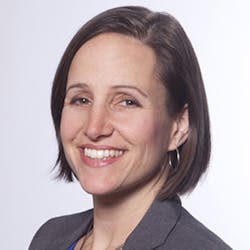Natalie Pageler, M.D., chief medical information officer at Stanford Children’s Health, realizes that her clinical informatics team is lucky to be located in the heart of Silicon Valley, where digital health innovation is thriving.
In a recent interview, Pageler said the 312-bed Lucile Packard Children's Hospital Stanford is ideally situated to partner closely with the university’s biomedical informatics experts and the School of Engineering on big data projects and new tools. In one example, a clinical informatics fellow looked at patterns in vital sign data in the data warehouse to revise vital sign alarm thresholds over time.
“Because we live in Silicon Valley, we also have the opportunity to work with companies such as Apple,” she said. A few years ago the health system announced that it was using Apple’s HealthKit to get continuous blood glucose monitoring from a patient’s home glucose monitor uploaded through their iPhones into MyChart, the patient portal, and then into Stanford’s EHR. “Then we created a data visualization tool called GluVue, an API-enabled app that displays all that data for clinicians,” she said.
“Now we are working with Apple again to do something similar with congenital heart disease,” Pageler added. “This concept involves some of our most fragile congenital heart patients and continually uploading their parameters” to guide caregivers.
She said Stanford Children’s Health is looking at several options to get the pool of data needed to enable care for diabetic patients, including data from insulin pumps. “With this digital health rollout, for our diabetic patients in particular, they won’t need to come into an academic medical center all the time for frequent appointments. They could do a lot of those appointments via virtual visits, and we pair those with home monitoring data uploaded to the EMR,” Pageler explained. “Then you stop disrupting their lives as much. You can provide care at home and prevent them from having significant deterioration. You are really flipping the entire model of healthcare delivery.”
Pageler has been CMIO at Stanford Children’s for a little over a year. She succeeded Christopher Longhurst, who left to become CIO at UC San Diego Health.
She said that like most physicians who get into informatics, there was a lot of serendipity involved. “I do have an engineering undergraduate degree, so I definitely have a bent toward technology and science and engineering,” she said. During her fellowship, she was getting a master’s degree in medical education and did her thesis work on clinical decision support as a form of just-in-time education and a way to change physician attitudes. “That is where I got involved in informatics,” she said.
CMIOs at pediatric hospitals deal with the same issues generally as their counterparts at adult hospitals, but there are some regulatory differences, Pageler noted. For instance, the early markers for Meaningful Use were very adult-focused. “So we find ourselves constantly uniting as a pediatric group and saying, ‘don’t forget us’ and trying to figure out how we can make the measures make sense for a pediatric population.” She added that because pediatrics involves a smaller population, there is less evidence for evidence-based medicine and fewer randomized clinical trials to participate in.
Pageler reports to CIO Ed Kopetsky. She has been involved in two EHR implementations, the second time helping lead implementation of Epic a few years ago. “I work very closely with the IS department, and within IS, I have a clinical informatics team and an EHR training team reporting directly to me,” she said.
Stanford Children’s Health has an enterprise data warehouse and participates in multiple registries around specific diseases. It participates in four pediatric cardiology registries and two national diabetes registries, for example. Also, Epic has recently launched a program called Cosmos that allows Epic sites to contribute their data for research. Stanford Children’s has contributed all its pediatric asthma data to that site.
Pageler’s interest in clinical decision support continues to this day. Her team’s focus is EMR-integrated web-based clinical decision support tools. “We have been working on this for a while,” she said. Previous CMIO Chris Longhurst was involved in developing BiliTool, a web-based decision support tool designed to help clinicians assess the risks toward the development of hyperbilirubinemia or "jaundice" in newborns over 35 weeks gestational age.
Stanford Children’s has continued that work with development of a premature infant bilirubin decision support tool. “There are not a lot of randomized controlled trials for our populations,” she explained. “High bilirubin levels are very dangerous for newborn infants and pre-term babies, but we don’t have a lot of data about that. We have created a tool using the best evidence we have that takes the age and bilirubin levels from the EMR and provides guidance on what the physician should do based on current evidence. The tool then looks at the outcomes of that guidance and uses that information to continually improve the tool.”
Another Stanford neonatologist is working with a Bay Area startup, InsightRX, to create a clinical decision support tool for the dosing of the antibiotic vancomycin. Dosing can be very challenging, particularly in pediatric patients because the way they metabolize the product changes and the dosing should change based on their weight, she said. They have created a tool that takes information from the EMR and uses an algorithm to recommend a new dosing strategy. It feeds information back into the EMR to see how levels ended up being after that recommendation, so it is following that concept of a learning health system, where you are both recommending something and then learning from practice, she said.
I asked Pageler if such tools could be easily shared between pediatric hospitals on different EHRs. “That is definitely the ideal,” she said. “We are well resourced as an academic institution. We have physicians pursuing these tools as part of their research, but not every organization is so blessed. There is definitely a desire to share. With the FHIR standard, there is the possibility of creating these web-based tools that could sit on top of other EHRs, for more people to take advantage of them,” she said. “There are lots of challenges with that. If you are going to make a tool widely available, you need a really strict process around updates and maintenance and accuracy. But that will be the wave of the future. FHIR is opening the doors widely to allow the development of this type of tool that can sit on top of other EHRs.”


